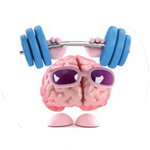Every child can grow more efficient and productive at school simply by being mindful of these 5 strategies, and then putting them into good use!
5 School-Savvy Smarts

This year will be 16 years since the release of the iPod and nine years following the debut of the first smartphone running on Android. If it supposedly takes 21 days to form a new habit, then we’ve had more than enough time to not just establish a touch screen tendency, but reinforce that many times over!
The habit has become so ingrained in our lifestyles it now appears that the average human attention span is even lower than that of a goldfish! In a 2015 study conducted by Microsoft, researchers claim that from 2000 to 2013, our attention spans fell from 12 to 8 seconds—one second less than a goldfish’s!
Certainly, no parent would desire their child to evolve into a habitual touchscreen goldfish! “Beginning in childhood, you have developed a series of conditioned responses that lead you to react automatically and unthinkingly in almost every situation,” says motivational speaker Brian Tracy.
Since these acquired actions begin from young, your school-going child is still at a receptive age to develop healthy habits. Following are 5 “school savvy” smarts which will set them in good stead for whatever challenges lie ahead — homework, tests and exams, making a place on the school’s sports team and so on.
#1: Use time efficiently.
At the crux of good time management is overcoming procrastination. Research has shown that the longer we drag our feet to get started on something, the harder to get motivated. Once the wheels of motion get turning, however, the feeling of happiness, lightness and relief is wonderful!
For example, if your kid gets stuck on a homework assignment, leave it and move on to the next piece, otherwise frustration will arise and make matters worse. Go back to it after a while once a momentum is set. Start first with whatever is liked the least or is considered the most challenging, and once that is out of the way and accomplished, reward the effort accordingly (an incentive always helps to move things forward!). That leaves the issue of tackling boredom, which leads us to…
#2: Understanding individual learning behaviour.
 Ask your kids what sort of approach usually works in capturing their interest and attention, and subsequently, how they keep engaged. Every student has a different learning style that needs to be optimised, and there are three dominant kinds of learners: auditory, visual and kinaesthetic. Auditory learners are most comfortable in a traditional classroom setting and absorb information best through listening to the spoken word. Visual learners respond best to materials they can see, such as diagrams, graphs, charts, videos and illustrations. Meanwhile, kinaesthetic learners enjoy active participation in practical activities using materials they can create or build with; or interacting through performance or movement.
Ask your kids what sort of approach usually works in capturing their interest and attention, and subsequently, how they keep engaged. Every student has a different learning style that needs to be optimised, and there are three dominant kinds of learners: auditory, visual and kinaesthetic. Auditory learners are most comfortable in a traditional classroom setting and absorb information best through listening to the spoken word. Visual learners respond best to materials they can see, such as diagrams, graphs, charts, videos and illustrations. Meanwhile, kinaesthetic learners enjoy active participation in practical activities using materials they can create or build with; or interacting through performance or movement.
Accommodate your child’s learning behaviour with appropriate study techniques that work best for him, and encourage him to prep in advance too (see #1!). Most kids respond well to the SQ3R method, which involves the survey of text for key information, creating questions, and reading, reciting, and reviewing material. Encourage these study skills at home and get your child to create his own revision materials, whether flashcards, mind maps, or detailed study notes. Allow your child to take breaks too, to avoid lethargy.
#3: Get enough sleep.
 Although this golden rule has been repeated to the point where it sounds stale, how many families are actually reinforcing this at home? In 2012, the Department of Paediatrics at the National University Hospital (NUH) published its results from a three-year study that found that local pre-schoolers aged two to six were sleeping much less than children in Switzerland, with doctors noting that lack of quality sleep might have repercussions on their “long-term health and academic performance”. Another sleep study done by NUH and Nanyang Technological University undergraduates had similar findings, but the children were aged six to nine this time. The study showed that 57.6 percent of the children slept less than nine hours on a school day when the optimal amount for them was to have nine to 10 hours of sleep. Dr Michael Lim, Consultant at the Division of Paediatric Pulmonary and Sleep at NUH, recommends that parents establish a regular winding down routine for their kids at least an hour before bedtime. Again, the NUH doctors warned that insufficient sleep can negatively affect their children’s academic performance.
Although this golden rule has been repeated to the point where it sounds stale, how many families are actually reinforcing this at home? In 2012, the Department of Paediatrics at the National University Hospital (NUH) published its results from a three-year study that found that local pre-schoolers aged two to six were sleeping much less than children in Switzerland, with doctors noting that lack of quality sleep might have repercussions on their “long-term health and academic performance”. Another sleep study done by NUH and Nanyang Technological University undergraduates had similar findings, but the children were aged six to nine this time. The study showed that 57.6 percent of the children slept less than nine hours on a school day when the optimal amount for them was to have nine to 10 hours of sleep. Dr Michael Lim, Consultant at the Division of Paediatric Pulmonary and Sleep at NUH, recommends that parents establish a regular winding down routine for their kids at least an hour before bedtime. Again, the NUH doctors warned that insufficient sleep can negatively affect their children’s academic performance.
Other than proper sleep, it’s just as important for children to take regular breaks away from their homework and study sessions to boost their brain’s ability to learn and retain information. While adequate rest is vital for the brain to function at its optimum best, it is equally important that the brain be kept energised with new cognitive challenges. This brings us to the fourth school-savvy smart (with due emphasis on the word “smart”)…
#4: Give the brain a workout.
 Research has shown that regular mental challenges produce a healthier brain, which in turn is better attuned towards creativity, problem-solving and critical thinking. Students who proactively attempt to learn something new every day are helping to keep their minds focused. Fortunately, the brain’s functions are not fixed at birth or after childhood—and its capacity to change and rewire itself in response to stimulation and experience is called neuroplasticity. The brain can benefit from a workout as much as the body can from physical exercise. This equivalent for the brain is engaging in activities that lights up its problem-solving mechanisms, but not every child will relish being given some tough problem sums to crack their heads over!
Research has shown that regular mental challenges produce a healthier brain, which in turn is better attuned towards creativity, problem-solving and critical thinking. Students who proactively attempt to learn something new every day are helping to keep their minds focused. Fortunately, the brain’s functions are not fixed at birth or after childhood—and its capacity to change and rewire itself in response to stimulation and experience is called neuroplasticity. The brain can benefit from a workout as much as the body can from physical exercise. This equivalent for the brain is engaging in activities that lights up its problem-solving mechanisms, but not every child will relish being given some tough problem sums to crack their heads over!
Unlike a computer, a brain requires stimulation and variety in order to remain interested in the task that it is occupied with. Taking frequent breaks or switching to another activity will ensure your brain stays alert and focussed.
Kids can also exercise their noggin in fun ways such as playing brain games that involve the memory and concentration. No touchscreens in the form of a computer, tablet or smartphone are necessary either! Conceive a game of recall using the power of association and connection, in which they use mnemonics (e.g. an image, word, phrase, etc) that help make it easier to remember something. Doing a Sudoku, crossword or jigsaw puzzle, unscrambling a Rubik’s Cube and learning to play a new game—like Go or chess—are also great ways for children to boost their brain power. The more they use their brain, the faster they become in conceiving different and out-of-the-box ways to tackle challenges. Any child that is able to approach his problems with confidence will, over time, develop a healthier mentality and mindset, which can be fuelled further by…
#5: Thinking positive
 The stuff of daydreams may be nothing more than a pipe dream if these are not followed up with the corresponding action; actions do speak louder than words after all. Kids can build a strong and healthy self-esteem if they are encouraged to think and behave in ways that make them the person they want to become. This has nothing to do with being disillusioned or unrealistic; it’s been shown that repeating positive thought patterns, processes or behaviours can spark new connections in the brain, known as “neural pathways”. The more these pathways are used or repeated over time, they will eventually become part of a person’s natural response mechanisms. Ask your child to define what being a success means to them.
The stuff of daydreams may be nothing more than a pipe dream if these are not followed up with the corresponding action; actions do speak louder than words after all. Kids can build a strong and healthy self-esteem if they are encouraged to think and behave in ways that make them the person they want to become. This has nothing to do with being disillusioned or unrealistic; it’s been shown that repeating positive thought patterns, processes or behaviours can spark new connections in the brain, known as “neural pathways”. The more these pathways are used or repeated over time, they will eventually become part of a person’s natural response mechanisms. Ask your child to define what being a success means to them.
“Success is the ability to live your life the way you want to live it, doing what you most enjoy, surrounded by people who you admire and respect,” says Brian Tracy. “One of the most important goals you must achieve to be happy and successful in life is the development of your own character. You want to become an excellent person in every respect. You want to become the kind of person that others look up to and admire. You want to become a leader in your community, and a role model for personal excellence to all the people around you.” Encourage your kids to think big along the lines of Tracy’s definitions, and to develop specific habits that will pave the way to the results they want to achieve!
Remember the 21 days it supposedly takes to form a new habit? This theory isn’t hard or fast. Experts contend that the speed in which a new habit develops is more accurately determined by the intensity of the emotion during the early stages of first acquiring, then forming the necessary actions behind the habit.
How badly or how much does your kid want the accomplishments that could possibly map out his future? Let’s offer a toast to our children’s success and drink to that! Brain and body really are inseparable: What you put into one you put into the other. Research shows that eating a wide variety of different foods is one of the very best ways to ensure both brain and body health.
Get your child off to a healthy start every morning by ensuring that they never miss breakfast, which remains the most important meal of the day. Complement this good habit with a daily bottle of BRAND’S® AlphaMynd Essence of Chicken with Vitamin B Complex, an easy-to-drink supplement specially formulated for children aged 2 to 12. With no added colouring or preservatives, chicken essence has long been trusted by generations as a source for overall nourishment and good health. This wholesome bottle of goodness is also fortified with Vitamin B Complex to optimise physical and mental development in growing children. With the necessary fuel, they will have the power and perseverance to keep on excelling day after day, in every area of their lives!
Bonus for Brainiacs!
We can’t get enough of over how wonderful and fascinating our brains are and that’s why we’ve included an additional section with 5 trivia treats about this marvellous organ!
The brain has about 100,000 miles worth of blood vessels. The blood vessels for one person’s brain alone would be able to encircle the earth more than four times!
The brain only makes up one to three percent of a body’s mass, but it uses at least 20 percent of all the oxygen we breathe—probably to sustain the over 100 billion neurons that are packed in it!
The brain risks significant and irreparable damage if it is deprived of air for even 10 minutes. Interestingly however, the brain is able to endure longer periods of oxygen disruption—albeit in extremely cold or sub-zero temperatures. Victims who have “drowned” in cold water have been successfully revived after as long as 40 minutes, with no neural damage.
The size of our brains is correlated to our body size and thus when compared with all animals, humans have the largest brain size when measured in this proportion (except the elephant whose brain is six times larger than the human brain). The human brain weighs an average of over 1.4 kilogrammes.
The brain is not capable of feeling pain as it does not contain any nerves that register pain. A neurosurgeon would be able to poke around in your brain and you likely wouldn’t feel a thing!



